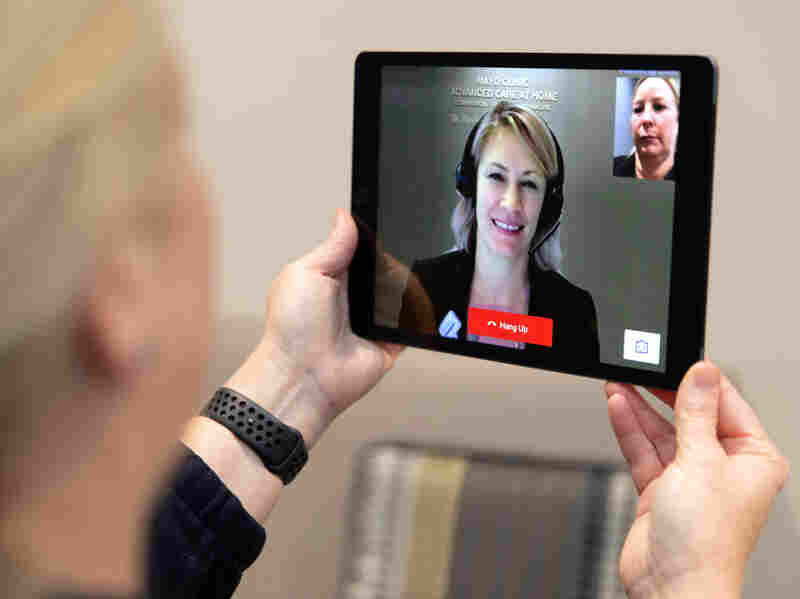
Dr. Michael Maniaci and Dr. Margaret Paulson confer at the Mayo Clinic's hospital-at-home command center in Jacksonville, Florida. Mayo Clinic
Late last year, Janet Yetenekian got seriously ill with COVID-19, sick enough to warrant going to the hospital. But instead, the hospital came to her. She got medical care in her own home in Glendale, Calif.
"It was even better than the hospital," Yetenekian laughs. "They were constantly reaching out — it's time for you to do your vitals, or it's time for you to take your medications."
Yetenekian contracted the coronavirus in December after friends invited her family to an afternoon barbecue. It seemed like a safe antidote to pandemic isolation. But the day after the gathering, the host came down with a fever. A test confirmed it was COVID-19.
Within two weeks, Yetenekian's husband and two teenage children got mild cases of the disease. She came down with a more serious case, however, and her blood oxygen plummeted to dangerously low levels.
She went to the hospital at Adventist Health in Glendale, where doctors told her she would need an intravenous infusion of the antiviral drug remdesivir and constant monitoring. And it surprised Yetenekian when her doctor offered to move all her care home to be monitored virtually.
Doctors and nurses at a command center nearly 200 miles away in the San Joaquin Valley town of Hanford, Calif., managed Yetenekian's care as part of a new federal effort aimed at freeing up hospital beds during public health emergencies. Under the model, about 60 illnesses — including COVID-19 — qualify for home treatment.
"Heart failure, pneumonia, skin infections — those are all patient populations we can safely care for in the home," says Dr. Margaret Paulson, who leads the Mayo Clinic's new home-based care program in rural Wisconsin.
Hospital care at home is nothing new for patients with low-level health needs. But since the pandemic, a growing number of health systems, including Adventist Health, Mayo Clinic and Kaiser Permanente (which is not affiliated with Kaiser Health News), are offering people with more serious health conditions hospital-level treatment in the comfort of their homes.
Paulson says once her patients understand that home care doesn't mean a step down from hospital care, they eagerly embrace it.
"Especially for patients who have been in the hospital a lot, to know that they can actually go home and sleep in their own bed and be with their family and have their pets by their side, it's just really reassuring," Paulson says.

Dr. Margaret Paulson interacts with a patient via a tablet as part of Mayo Clinic's home-based hospital care program. Paulson says once patients understand that hospital-at-home care does not mean less care, they embrace it. Mayo Clinic
And studies suggest at-home care provides better outcomes for patients and costs less to provide than traditional inpatient care.
"This is actually a higher level of touch from physicians and advanced practitioners," says Dr. Kavita Patel, a physician and health policy fellow at the Brookings Institution.
Regular videoconferencing and 24/7 monitoring are augmented by twice-daily in-person visits by nurses and other health workers who provide basic care — such as IV antibiotics — that can't be given virtually.
"This isn't just sending mom or dad to the bedroom," Patel says.
The technology infrastructure is key, Patel says, for patients and doctors. It includes giving patients one-way phones that ring directly into a hospital's command center, specially programmed iPads that immediately link via videoconferencing with health professionals, and wearable devices with emergency call buttons.
At-home hospital care took off last year when the Centers for Medicare & Medicaid Services expanded a program intended to provide more flexibility for health care systems to treat patients with COVID-19 and other acute conditions outside of overcrowded hospitals. Hospitals that are part of this program can now bill Medicare.
Mayo Clinic and Kaiser Permanente announced on May 13 a combined $100 million investment in Medically Home, a Boston-based technology company that supports at-home programs for health care systems, including Adventist Health, to help expand the service.
Raphael Rakowski, co-founder of Medically Home, says another selling point of the at-home care model is that there are no facility transfers as patients heal.
"We stay with the patient until they're fully recovered, and that averages anywhere from 20 to 30 days, sometimes longer," he says. "So we substitute not just for the hospital, but for all the care that follows."
Still, not every patient is a fit. To be eligible for care at home, patients must live within 30 minutes of emergency care; they also need high-speed internet, and, says Patel, they can't be too sick.
"This can't be something where it's so complicated that you are monitoring a patient, worried that they could crash and need to be in the ICU within minutes," she says.
But for moderate COVID-19 and dozens of other conditions, acute hospital care at home is likely to become a more common option as more health systems adopt the program and even more diseases are included. It is offered now at 129 hospitals in 30 states.
Kaiser Health News is a nonprofit, editorially independent national newsroom funded by the Kaiser Family Foundation. KHN is not affiliated with Kaiser Permanente.
"care" - Google News
May 20, 2021 at 04:01PM
https://ift.tt/3u4eoJx
Hospitals Offer In-Home Care As An Alternative For Some Acute Illnesses : Shots - Health News - NPR
"care" - Google News
https://ift.tt/2N6arSB
Shoes Man Tutorial
Pos News Update
Meme Update
Korean Entertainment News
Japan News Update
Bagikan Berita Ini














0 Response to "Hospitals Offer In-Home Care As An Alternative For Some Acute Illnesses : Shots - Health News - NPR"
Post a Comment